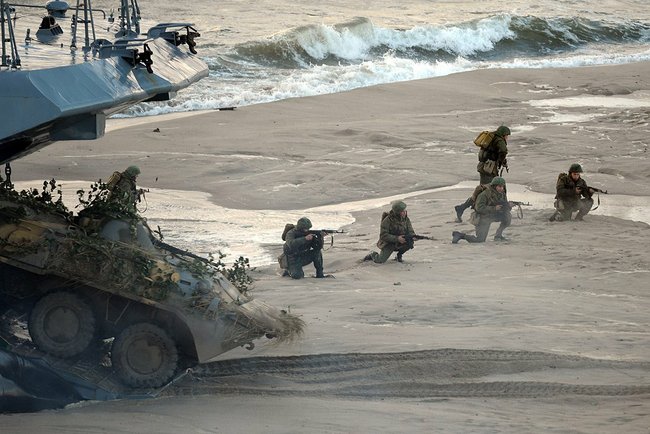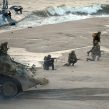
What Do the Zapad 2013 Exercises Reveal? (Part One)
Publication: Eurasia Daily Monitor Volume: 10 Issue: 177
By:

Summer through early fall is traditionally the main exercise season for Russia’s armed forces, and 2013 was no different from preceding years. Russian exercises are important because they reveal where, against whom and in what form Russia is preparing to wage war. This year’s seasonal military drills culminated in late September with the Zapad (“West”) 2013 exercises that encompassed several firing ranges and training areas in the Russian Federation and Belarus (see EDM, September 26). Like its predecessor, Zapad 2009, this exercise was deliberately misnamed. As in 2009, it was called “Zapad” or “West” to confound foreign observers into underestimating its scope. But in fact, the September 20–26 drills stretched all the way from the Arctic to Voronezh and simultaneously involved all branches of Russia’s armed forces—land, sea, air, air defense and airborne—special forces (Spetsnaz), the Internal Troops of the Ministry of Interior (VVMVD) in a “snap inspection,” and even medical and army psychological personnel, not to mention the logistical and engineering forces, which took part in these simultaneous exercises (Strazh Baltiki, September 28; Zvezda TV, September 20; Foreign Broadcast Information Service–Central Eurasia [FBIS SOV], September 18, 20, 26, 28; Interfax-AVN Online, September 13, 18; Vo Slavu Rodiny Online, September 26).
As the press finally admitted, the Zapad 2013 exercises amounted to a comprehensive review of the command and control (C2) systems, the ability of the armed forces to complete combined forces operations (i.e. with the Belarusian military, including its Spetsnaz), as well as a thorough testing of the joint operations of Russia’s armed forces where land, sea and air forces operated together simultaneously in a single operation. As a result, Russia could not have mobilized, transported, and deployed just 10,000 men, as some sources claimed. Rather the figure, according to unofficial Western estimates by individuals speaking off the record must have been closer to 70,000. It should be noted in this context that Russia’s ability to mobilize, transport, and deploy such large numbers points to considerable improvement in its armed forces’ capabilities, especially when compared to the relatively modest 6,000 troops that the North Atlantic Treaty Organization (NATO) plans to muster for its upcoming November 2013 Steadfast Jazz exercise in the Baltic—which is clearly a reply to Zapad 2013 (Ministry of Defense of the Republic of Belarus, FBIS SOV, September 23; Rzeczpospolita, October 1).
Russian claims that the purpose of the exercise was to test the effectiveness and reliability of the C2 reforms introduced since 2008 as well as to experiment with combined and joint operations based on those same reforms are true (FBIS SOV, October 3). But they do not represent the whole truth. Indeed, the maneuvers and drills conducted during Zapad 2013 reflected virtually the entire range of conceivable military operations except for nuclear strikes, which Russia had practiced in the Zapad 2009 and Vostok (“East”) 2010 exercises. The absence of a nuclear element in Zapad 2013 may reflect concern over the unfavorable publicity generated by the reports of a simulated nuclear strike on Warsaw in Zapad 2009. Nevertheless, Russian nuclear weapons remain a priority item in Moscow’s defense procurement budget. But their absence from this year’s drills may also reflect Russian interest and greater confidence in using precision-strike long-range ballistic missiles as a deterrent, along with long-range strike forces as those systems come on line. Certainly President Vladimir Putin is on record pushing for making such forces a priority in the Russian military (VES Online, September 24; FBIS SOV, September 24, 28; Na Strazhe Rodiny, September 28; kremlin.ru, September 19).
At the conventional level, Zapad 2013 featured search and rescue, amphibious landing and anti-landing operations, air and ground strikes on enemy targets, anti-submarine warfare, missile strikes with long-range precision strike assets, airborne and air assault operations, and so on across the entire expanse from the Arctic to Voronezh. According to reports, the training scenario featured an attack and/or landing by “Baltic terrorists” targeting Belarus in which these forces held out despite numerous assaults by the Russo-Belarusian defenders. The enemy forces then fled into cities, leading to urban operations to dislodge them—hence the integration of anti-terrorist and conventional operations. These “terrorists” conducted an amphibious landing on the Baltic Sea coast, employed Mi-24 helicopters, SU-25 and Su-30 strike aircraft, as well as conducted ship-to-shore fire from naval vessels of the Baltic Fleet (Izvestiya Online, September 26; The Moscow Times, September 30; Krasnaya Zvezda Online, September 28; FBIS SOV, September 26, 28). Thus, these “terrorists” appear to have been a deliberately misnamed surrogate for NATO.
But the real scope of these operations did not end there. In Central Asia, a Russian-led multi-national exercise, Vzaimodeistiviye (“Mutual Action”), comprising forces of the Collective Security Treaty Organization (CSTO) also took place at the same time (see EDM, September 26). Furthermore, Russia carried out concurrent joint exercises with Mongolia. And immediately after Zapad 2013’s conclusion, a Pacific Fleet exercise in Russia’s Primorye (Maritime) Province went forward, sending clear signals to China (FBIS SOV, September 7, 13; Suvorovskiy Natisk, September 7).
In all these cases Moscow, or more specifically Chief of Staff, General Valery Gerasimov, contended that Russian forces were conducting nothing more than an anti-terrorism operation and had no specific enemy in mind. However, Polish, Baltic, and Nordic observers all registered alarm about these operations because Zapad 2013—perhaps with the Libyan and Syrian examples in mind—folded anti-terrorist operations and urban warfare into a larger scenario that also embraced classic large-scale conventional theater operations involving combined and joint operations, missile strikes, and so on. Indeed, the participation of VVMVD forces suggested not just an anti-terrorist urban operation, but a broader effort to conduct a large-scale mobilization of the total armed forces at the government’s disposal: i.e. a large-scale war that included a terrorist scenario, as in the Middle Eastern conflicts cited above. In fact, Gerasimov emphasized that “[the Russian military] worked on the interoperability of all the branches and combat arms and also of the other agencies mobilized in the exercise” (Interfax-AVN Online, FBIS SOV, September 19, 27). The crowning evidence for this assertion, and an element of the exercise that did not receive much press, is the fact that as part of Zapad 2013, a mobilization of reservists in Leningrad and Nizhny Novogorod oblasts, as well as the energy, transport and interior ministries took place—a telltale sign of a large war scenario (Interfax-AVN Online, September 27; 47 News, September 20; FBIS SOV, September 20, 27).




